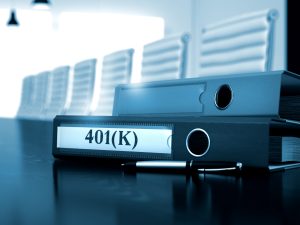
Since your 401k audit is over, it is time to forget your plan and start thinking about everything else. That is until next year’s 401k audit, right? Far too often we see this type of thinking and it can get you and your company into some deep water. The Department of Labor is taking retirement plans very seriously and they are looking at the Fiduciaries to oversee the plan.
Fiduciaries are the individuals who are in charge of administering the plan for the Company. This can also include the board of directors of the Company as the board appoints the fiduciary. Did you know that fiduciaries can be personally liable for any losses or expenses and could also face criminal punishment if they breach their fiduciary duty? So what is your
Fiduciary duty? The Department of Labor (DOL) states that “the primary responsibility of fiduciaries is to run the plan solely in the interest of participants and beneficiaries and for the exclusive purpose of providing benefits and paying plan expenses.”
From our experience at LSL CPAs, below are some of the most significant areas that have been overlooked by fiduciaries.
1. Follow the Plan document
When was the last time you reviewed the plan’s plan document? I mean reviewed the plan document and not just amended it to satisfy the most recent ERISA requirement. The Plan document is the details of how the plan should operate. This includes, what compensation is and is not included in the calculation for contributions, participant loans requirements, distribution requirements, who is eligible to participate in the plan, etc. If you are not following the plan document, then the Company, and possible the fiduciary, will be held liable for not following the plan.
2. Timely contribution remittance
The requirement for remitting contributions and participant loan repayments is the earliest date the employer can reasonably segregate these amounts from its general assets, but in no event later than the 15th business day of the month following the month in which the employer withheld the contributions from the employee’s paycheck. Some companies think that this means that you can wait until the 15th business day of the following month. This is completely false and really should be taken out of the requirement. You should remit the contributions as soon as administratively possible. The DOL takes a very serious approach to this. The DOL has gone as far as saying that if you remit the contributions to the plan custodian on the same day as the pay date that sets the precedence and any other remittances during the year that are over zero days is considered late. I believe that is pretty extreme and during our audits I would not consider a couple days after the pay date late, but I do warn every company about this and that it is a possibility that the DOL could come back and determine that they are late contributions. When there are late contributions, the company has to remit lost earnings on the late contributions and remit excise tax on those lost earnings. There are multiple ways to calculate lost earnings and we can help in determining the best way for your company.
3. Investment decisions
It is good to have enough investments to ensure that the plan is properly diversified, but it is recommended to not have too many investments in which you can’t keep track of all of the investments. In addition, you should be reviewing the investments at least quarterly for any underperforming investments. If there is a trend with an investment, then it is time to think about switching from that investment offering. Many companies do not have that type of expertise to ensure that the correct investments are being offered by the plan. We recommend that the company use an investment advisor or third party administrator to help with that review. LSL does not offer these services, but we know many different advisors that do and can guide you in the right direction.
4. Participant elections and employee files
You should always ensure that the percentage withheld from the employees match the participant election forms. Many times, there are differences between those two. If this is the case, then the company will be liable for that difference along with the possible matching contribution and lost earnings. For one participant, this could be a significant amount of money. We recommend that the company audit this internally throughout the year. A good practice would be to take 10 to 20 employees each month and compare the percentage on the election form to what is being withheld from the
paychecks. In addition, many elections are online elections. When you get changes percentages emailed from the plan custodian, print that email and include it in the participant file. If you ever were audited by the DOL, you will have this information readily available for them and there will be no questions asked.
a. Example of incorrect contributions. Assuming an employee who has worked at the company for 5 years makes $50,000 per year and elected 5%. There is a match of 50% of employee contributions and an average of 6% earnings on investments over the 5 years. If the company accidentally withholds 2% instead of the 5%, the company is on the hook for the difference, along with the match and lost earnings totaling $11,925. See the calculation
below.
50,000 (Compensation of employee)
.03 × (Difference between the 5% elected and
the 2% withheld)
————————–
1,500 = (Yearly difference)
5 × (5 years employed with the difference)
————————–
7,500 = (Employee contribution amount owed)
.5 × (50% match missed)
————————-
3,750 = (Employer contribution amount owed)
7,500 (Employee contribution amount owed)
3,750 + (Employer contribution amount owed)
————————–
11,250 = (Total contribution amount owed
.06 × (6% average rate of return)
————————–
675 = (Lost earnings)
11,250 + (Add total contribution amount owed)
————————–
11,925 = Total amount the company is liable for
5. Selecting the correct service providers
As mentioned above, it is important to use an investment advisor in your plan. You should ensure that they are reviewing the investments held by the plan at least quarterly. In addition, many companies will hire the auditor based solely on fees. While it is a good idea to save your company some money, you are playing with fire. If the audit fees are under $8,000 then the auditors are not auditing your plan correctly. They are likely cutting corners and will fail under a DOL audit. If that happens then you have to hire a new auditor and pay for interest and penalties for a late audit. This can be a substantial amount of money, all because you tried to save your company some money without looking at the CPA expertise in the area. This leads me to the next point which is to ensure your auditor has the expertise to audit the plan. Retirement plans are very specialized and it does require an expertise in this area.
If you have any questions on your retirement plan or need assistance with anything, LSL is always here to help. We are focused on your retirement plan needs.
Click here for more details about our Pension Plan Audit services.




